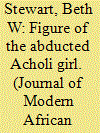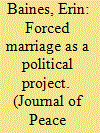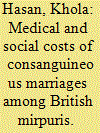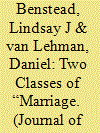|
|
|
Sort Order |
|
|
|
Items / Page
|
|
|
|
|
|
|
| Srl | Item |
| 1 |
ID:
190846


|
|
|
|
|
| Summary/Abstract |
We introduce a new dataset, Contemporary Slavery in Armed Conflict (CSAC), coding instances and types of enslavement in armed conflict from 1989 to 2016, building on Uppsala Conflict Data Program data. CSAC currently covers 171 armed conflicts from 1989 to 2016, with the unit of analysis being the conflict-year. We identify different types of enslavement within these conflicts and find that 87% contained incidences of child soldiers, 34% included sexual exploitation/forced marriage, 23% included forced labor, and 16% contained instances of human trafficking. The use of enslavement in armed conflict to support strategic aims is also identified and found in about 17% of cases. Next, drawing upon key variables from the Uppsala Conflict Data Program, we present a series of cross-tabulations looking at the presence of slavery and conflict broken down by conflict incompatibility, intensity level, and type. We see the coding of slavery within conflict as a step toward generating greater understanding of when and how state and non-state actors use enslavement within conflict, with the goal of mitigating and possibly eradicating slavery in warfare.
|
|
|
|
|
|
|
|
|
|
|
|
|
|
|
|
| 2 |
ID:
178008


|
|
|
|
|
| Summary/Abstract |
Based on analysis of newspapers and secondary sources, this article examines the gendered construction of the national imagery of the war between the Ugandan government and the Lord's Resistance Army (LRA) in an effort to expand current conceptual understanding of the exclusion experienced by children born of forced marriage inside the LRA. Uganda developed as a militarised and masculine post-colony and yet nation-building for President Museveni involved crafting a national imagery that drew upon development discourses of gender and children to position himself as the benevolent father of the nation. Invoking Veena Das’ ‘figure of the abducted woman’, I argue that the Ugandan government mobilised the figure of the abducted Acholi girl to legitimise both its governance and the war. The article concludes that the resulting narrative provided no legitimate social or political space in the national imagery for the children of the abducted girls.
|
|
|
|
|
|
|
|
|
|
|
|
|
|
|
|
| 3 |
ID:
132354


|
|
|
|
|
| Publication |
2014.
|
| Summary/Abstract |
One of the most vexing contradictions about the Uganda originated rebel group, the Lord's Resistance Army (LRA), is the fact that it institutionalized forced marriage on the one hand, while actively discouraging sexually immoral behavior on the other: rape, sexual violence, and promiscuity both within the group and outside it were punishable by severe beating or death. What explains this contradiction? The article suggests that in addition to maintaining discipline and control over a diverse and reluctant group, forced marriage and the regulation of sexual relations reproduced a political project of imagining a 'new Acholi' nation. The article draws on original data collected in focus group discussions with former commanders and wives to commanders to discuss the historical evolution of this vision, how the LRA enforced rules regarding sexual behavior, and finally, the way forced marriage implicated women and girls in the organization of power and domination in the group until it was forced from permanent bases in Sudan in 2002.
|
|
|
|
|
|
|
|
|
|
|
|
|
|
|
|
| 4 |
ID:
091735


|
|
|
|
|
| Publication |
2009.
|
| Summary/Abstract |
Consanguineous marriage has been widespread within the Pakistani Mirpuri community in Britain today. Such marriage arrangements are now increasingly perceived to create various problems and harms, including a high degree of insularity with barriers to integration and lack of contact with the wider community. Many instances of forced marriage give rise to human rights concerns. Since such marriages are often arranged with partners from Pakistan to aid the extended family financially, large-scale immigration from Pakistan into Britain continues. Many of these new spouses cannot speak English and are unfamiliar with English culture, which continues to slow down the pace of integration of Mirpuris. The article highlights particularly that the rates of consanguineous marriage are increasing within this particular community despite awareness of the medical risks involved, including an increase in congenital defects and infant mortality. Serious and culturally sensitive thought needs to be given on all sides, therefore, to addressing such issues rather than infl ating controversies and damaging community relations.
|
|
|
|
|
|
|
|
|
|
|
|
|
|
|
|
| 5 |
ID:
182865


|
|
|
|
|
| Summary/Abstract |
Some Somali majority clan girls and women receive economic and security benefits from marriage to Al-Shabaab fighters. Yet, the literature treats women’s experiences monolithically and misses the role that race plays in determining the circumstances of such unions. The authors argue that one should not refer to the unions of Somali Bantu girls and women with Al-Shabaab fighters as a “marriage” but rather as sexual and domestic slavery – a form of extraction by Al-Shabaab that works to ethnically cleanse the Bantu from their ancestral land. Drawing on data from an original survey conducted in 2017 of 139 Somali Bantu refugee households who fled to Kenya during the previous year, the authors examine the nature and extent of unions between females from different races with Al-Shabaab fighters. Women and girls from majority clans are more likely to marry fighters freely. Compared to majority clan females, Somali Bantu girls are enslaved by Al-Shabaab fighters at younger ages and typically remain with their own families rather than moving to the man’s household, contrary to Somali’s patrilineal marriage customs. Al-Shabaab fighters do not claim the children they have with Somali Bantu girls and women, whom they despise as a racially distinct minority with low social status. This work underscores the need to avoid the term “marriage” when referring to the sexual slavery of minorities in Somalia by Al-Shabaab and for the international community both to investigate claims of ethnic cleansing as well as support the fledgling Somali government in establishing a system of rule of law.
|
|
|
|
|
|
|
|
|
|
|
|
|
|
|
|
|
|
|
|
|